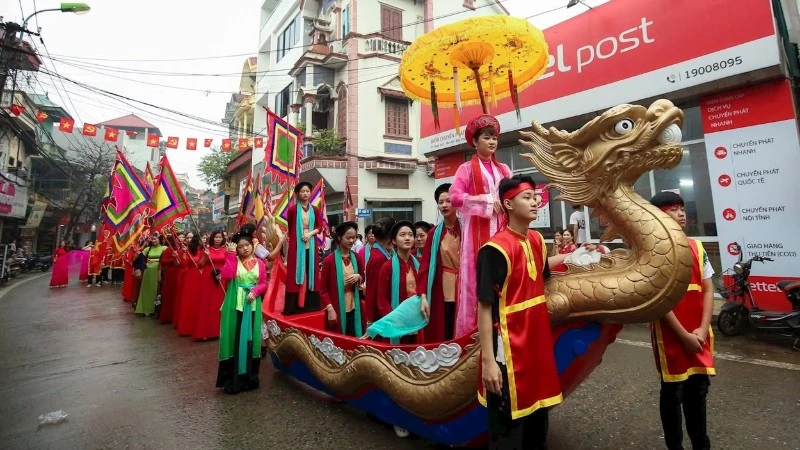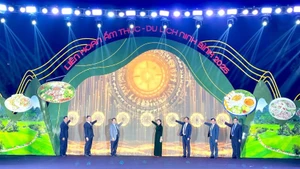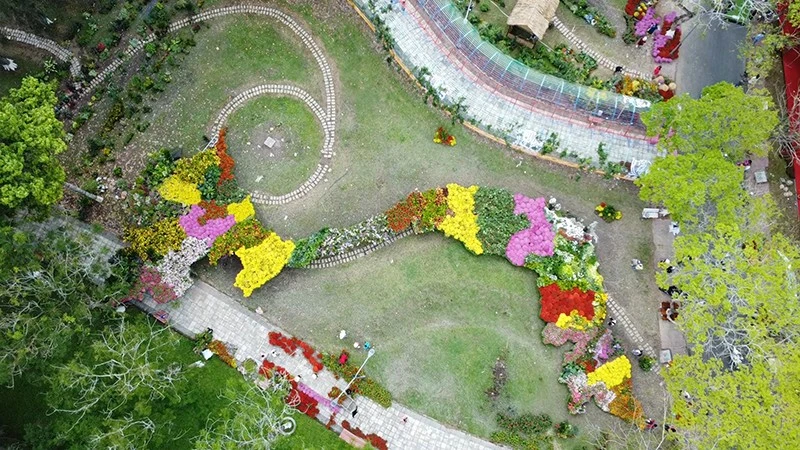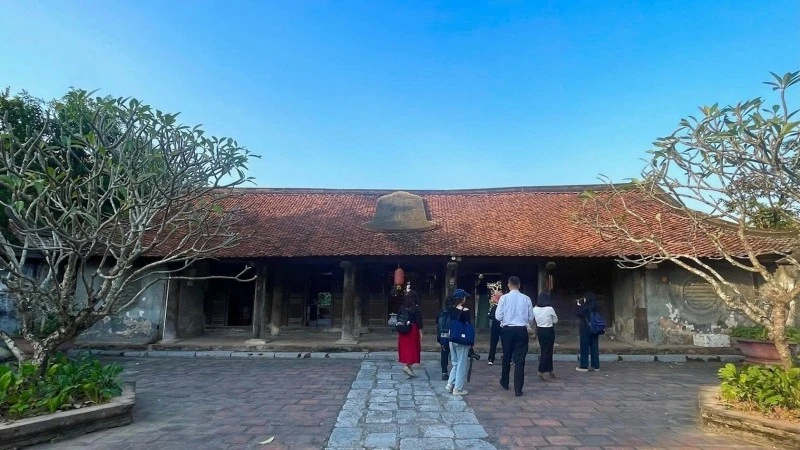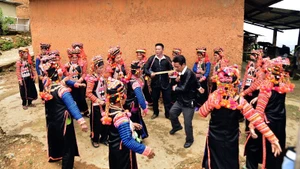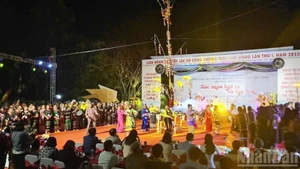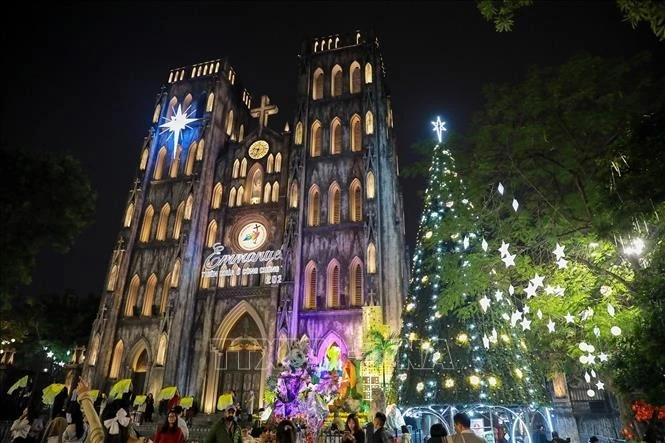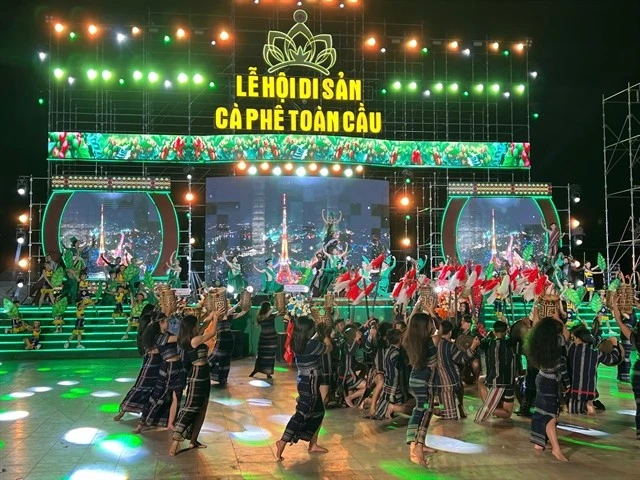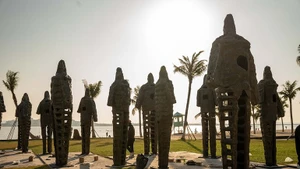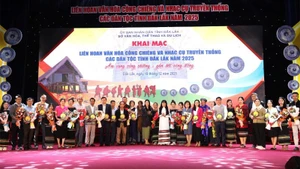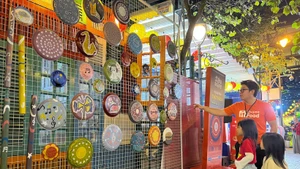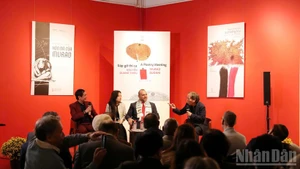Every summer, amid the usual childhood games, children in Dan Nhiem Village (formerly of Khanh Ha Commune, Thuong Tin District, now part of Thuong Tin Commune, Ha Noi) engage in a unique and surprising activity: learning and performing 'trong quan' singing.
A journey of revival
The singing classes are organised by the Khanh Ha ‘Trong Quan’ Singing Club and has drawn nearly 20 boys and girls. Each week, the children gather at the home of Meritorious Artisan Nguyen Thi Diep to be taught. Hearing the children’s voices, Meritorious Artisan Nguyen Thi Vay is deeply moved. At nearly 90 years old, she once believed she would never witness such a scene again. ‘Trong quan’ is a traditional folk singing style unique to Dan Nhiem and Khanh Ha Commune.
Elders recall that in the past, especially under the full moon, young men and women would gather to sing along the Nhue River. When Vay was young, ‘trong quan’ was still widely practiced. While the songs faded during the two resistance wars, many believed they would resurface in peacetime. However, as other heritage elements revived, the melodies of ‘trong quan’ continued to fade from the memory of Khanh Ha’s residents.
It was not until 2008 that the Khanh Ha ‘Trong Quan’ Singing Club was founded. Initially, activities were sporadic. Gradually, though, ‘trong quan’ began to attract the attention of local authorities and the cultural sector. The club received support in terms of equipment and funding. Vay’s knowledge was documented and passed on. She was invited to perform and present on major stages. While there was once resistance from families who did not want their children to join, attitudes have changed.
“I am weak now and my voice has diminished, so I cannot teach as much. But hearing the children sing brings me great joy. They are the future of ‘trong quan’ singing,” said Meritorious Artisan Nguyen Thi Vay.
Ha Noi is home to 1,793 intangible cultural heritage elements, spanning various domains: performing arts, social practices and beliefs, traditional crafts, festivals, and folk knowledge. In particular, performing arts and folk knowledge are the most vulnerable to extinction, as they are especially susceptible to changing social contexts and values. Practices such as ‘cheo tau’ singing in Tan Hoi, ‘do’ singing in Liep Tuyet, ‘trong quan’ in Khanh Ha, ‘Ai Lao’ dance-singing, and the coded slang of Da Chat were once on the verge of disappearing due to a lack of practitioners. However, Ha Noi has now virtually cleared the list of intangible heritage at risk of extinction.
Like Vay, Meritorious Artisan Ngo Thi Thu, who teaches ‘cheo tau’ singing, a form believed to date back to the 15th century, expresses deep emotions when guiding young learners. From Thuy Hoi Village, O Dien Commune, Thu recalls her arduous journey to collect the remaining verses of ‘cheo tau’ singing from Tong Goi (former name of Tan Hoi Commune, now part of O Dien) and her quest to find people to teach. At times, she felt alone and uncertain whether she could restore the art form. One of the unique challenges of ‘cheo tau’ singing is its ritual cycle, as the major festival is held only once every 25 years and lasts seven consecutive days with numerous complex performance segments. As a result, many people only experience it a few times in their lifetime, and retrieving the content from elders’ memories proved incredibly difficult.
Fortunately, people like Thu held on to fragments of the songs through lullabies and daily life. With other cultural enthusiasts, she reconstructed the songs from these remnants and gradually systematised them. Fortunately, the love of the artisans met with supportive city policies and government assistance, making revival possible.
“I never imagined that from such fragments, we and the researchers could reconstruct and refine the three main types of songs: ‘hat trinh’ (ceremonial singing worshipping gods and goddesses), ‘hat trao’ (singing while rowing), and ‘hat giao duyen’ (courtship singing), and share them widely”, Thu shared.
At the beginning of 2025, the Tong Goi ‘Cheo Tau’ Festival was officially inscribed into the National List of Intangible Cultural Heritage. This recognition is a powerful testament to the revival of a heritage once teetering on the brink of extinction. Most encouraging of all, the Tan Hoi Cheo Tau Club now has 50–60 active members. Both instructors and learners receive financial support. Each year, the city provides the club with 20 million VND to sustain its operations. Similar stories related to other heritages are playing out throughout Ha Noi.
Accompanying the artisans
Although 'ca tru' (ceremonial singing) remains on UNESCO’s list of Intangible Cultural Heritage in Need of Urgent Safeguarding, Ha Noi presents a different picture, one of vibrancy and revival. Currently, the capital boasts 14 clubs and guilds dedicated to ‘ca tru’, involving hundreds of practitioners and around 30–40 artisans capable of teaching the art. This notable contrast stems from Ha Noi’s strategic and well-structured policy framework that serves as a solid foundation for the heritage's revival.
The Ha Noi Municipal Department of Culture and Sports has thoroughly reviewed its intangible cultural assets, identifying heritage elements with unique value, those at risk of extinction, and especially those that meet both criteria for prioritised preservation efforts. Once selected, these heritage elements receive targeted support in terms of funding for activities and teaching. The department also cooperates with artisans to research, collect, and compile materials, later returned to the artisans for continued transmission. Some standout examples of such prioritised heritages include: Da Chat coded slang (Dai Xuyen Commune); the keo mo (bamboo stick pulling) festival in Xuan Thu (Da Phuc Commune), ‘cheo tau’ singing in Tan Hoi (O Dien Commune), Ngai Cau ‘ca tru’ singing (Hoai Duc Commune), and Ai Lao dance-singing (Viet Hung Ward)
A major breakthrough in safeguarding intangible cultural heritage has come with the passage of Resolution No. 23/2022/NQ-HDND, issued by the Ha Noi Municipal People’s Council in December 2022. The resolution outlines specific support policies for People’s Artists, Meritorious Artists, artisans, and outstanding clubs in the field of intangible cultural heritage.
Resolution No.23 is built on three main pillars including support for artisans, for heritage practice clubs, and for teaching and training. This policy is further reinforced by the professional assistance from the Department of Culture and Sports and additional financial backing from local authorities, helping heritages survive strongly.
To date, the Ha Noi Municipal Department of Culture and Sports has reviewed and approved 43 club establishment dossiers. Based on these approvals, local authorities have officially recognised and established heritage clubs. Dozens of these clubs have met all requirements to become eligible for state financial support, with 50 million VND for newly established clubs and 20 million VND annually for regular operations.
Bui Thi Huong Thuy, Deputy Head of the Cultural Heritage Management Division (under the Ha Noi Municipal Department of Culture and Sports)
Bui Thi Huong Thuy, Deputy Head of the Cultural Heritage Management Division (under the Ha Noi Municipal Department of Culture and Sports) said: “Providing financial support for artisans is relatively straightforward, as it is based on the official list of recognized artisans. However, supporting clubs is more complex. It must comply with Government Decree No. 45/2010/ND-CP on the organisation, operation, and management of associations, which sets strict requirements on club charters, headquarters, founding boards, and member status. Most clubs previously failed to meet these conditions”. In response, the department has worked closely with localities to re-establish the clubs under proper regulations. Once formalised, these clubs can access financial aid not only for establishment and annual operations but also for training and rehearsal sessions related to performances. The artisans can receive this support in addition to their monthly stipends.
An inspiring example of this revival is ‘hat do’ (do singing) in Liep Tuyet (now Kieu Phu Commune), a unique genre that praises Tan Vien Son Thanh (Tan Vien Mountain Saint). This form of folk singing was once on the brink of extinction. People’s Artisan Nguyen Thi Lan shared her joy in saying: “Never before have artisans like us received such recognition and support. Although the financial aid is not yet large, it serves as great encouragement to continue preserving our heritage. I’m now focused on mentoring the younger generation to ensure Liep Tuyet ‘do’ singing lives on.”
As a capital city with rich heritage, Ha Noi has always been home to devoted artisans. Yet love alone is not enough. The difference now lies in the implementation of thoughtful, practical policies that strengthen this passion, creating a solid foundation for the continuation, preservation, and flourishing of intangible cultural heritage.
